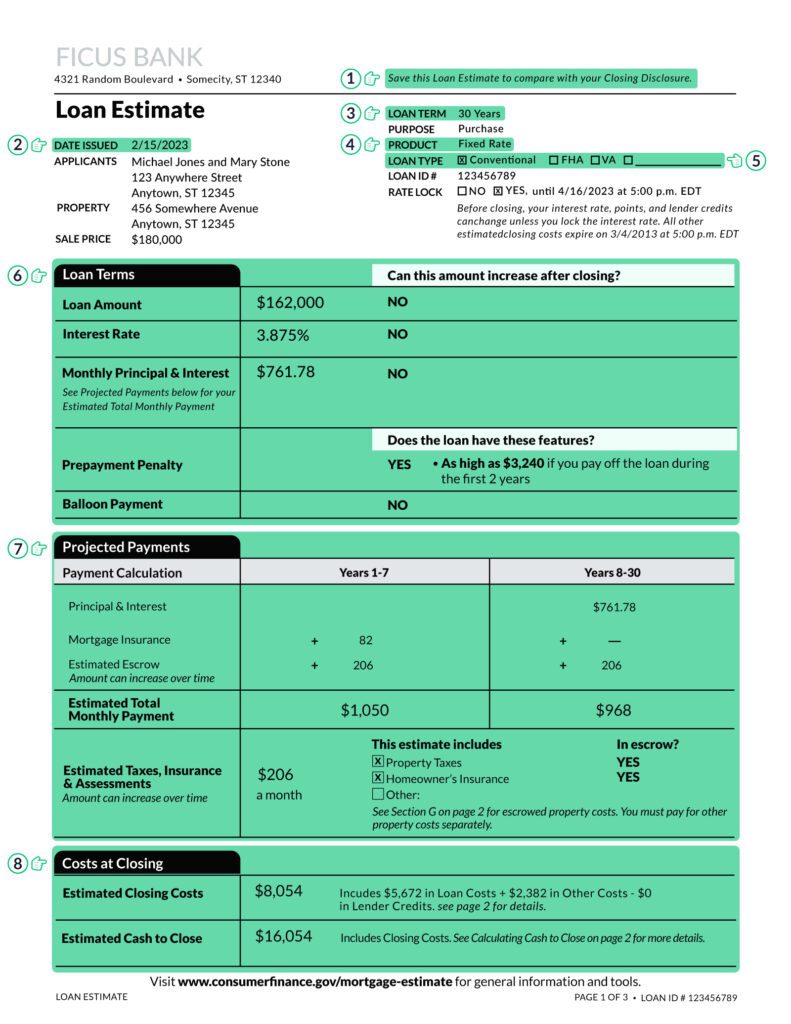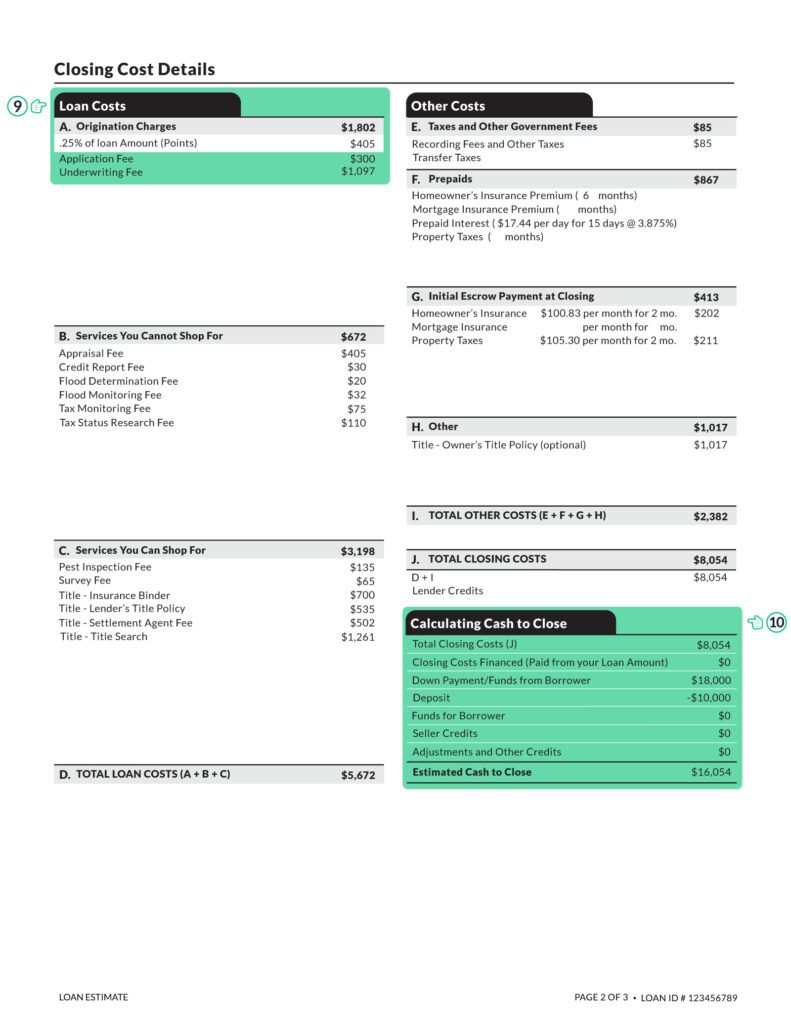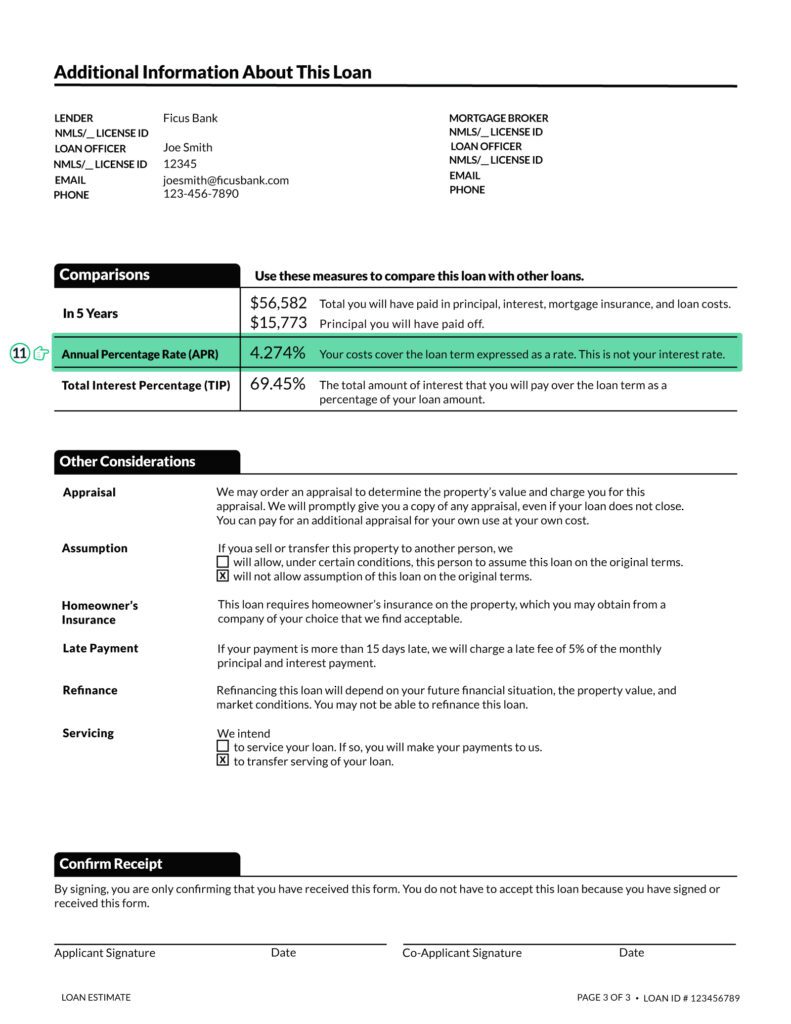Loan Estimate Example: Where to Find 11 Essential Items
Even if poring over mortgage documents isn’t exactly your idea of fun, one document you should pay special attention to is the loan estimate.
This three-page form is packed with important information about your mortgage, plus the details you’ll need to compare offers from different lenders. Below, we’ll walk through a loan estimate example, showing you page-by-page where to find the most essential information.
What is a loan estimate?
A loan estimate explains important features of a mortgage you’ve applied for, like your interest rate and estimated closing costs. The Consumer Financial Protection Bureau (CFPB) requires all lenders to use a standardized form to present the information, making it easier for consumers to compare the details of each loan offer they’re received.
To view a sample loan estimate, keep reading. We’ll map out the anatomy of this important document and make it easy to find what you need.
Example: What items appear on a loan estimate
The loan estimate contains three pages of information about your loan. Below is a loan estimate example highlighting the 11 most important details to review.
Page 1 of the loan estimate

1. “Save this loan estimate to compare to your closing disclosure.”
This is an important reminder that lenders are legally required to honor the interest rate offer that’s been given in a binding loan estimate (more on that below).
→ Remember to save your loan estimate to make sure it matches the final fees listed on the closing disclosure you’ll receive right before finalizing your loan.
2. Date issued
Your lender must send you a loan estimate within three business days of receiving your loan application.
![]() Tip: Because mortgage rates change daily, if you want to make the best comparison among several loan options, you should apply for loan estimates from each lender on the same day.
Tip: Because mortgage rates change daily, if you want to make the best comparison among several loan options, you should apply for loan estimates from each lender on the same day.
3. Loan term
If you see a loan offer with a very low rate, make sure to check the loan term. Mortgages with shorter terms generally come with lower rates, but their payments have to be higher because there’s a shorter repayment period. On the flip side, you can get more affordable payments with a longer loan term, but expect to see a higher interest rate.
![]() Considering refinancing to change the length of your loan term? Use a mortgage refinance calculator to determine whether a 15- or 30- year loan is right for you.
Considering refinancing to change the length of your loan term? Use a mortgage refinance calculator to determine whether a 15- or 30- year loan is right for you.
4. Product
The two most common loan products are fixed-rate and adjustable-rate mortgages (ARMs). Some lenders like to highlight ARMs because they offer lower rates than fixed-rate loans. However, that rate is only for a temporary period — typically three, five or seven years. After that, an ARM’s rate will fluctuate based on broader economic factors.
![]() Tip: Make sure you’re not comparing rate quotes for loans that have different terms and repayment structures.
Tip: Make sure you’re not comparing rate quotes for loans that have different terms and repayment structures.
5. Loan type
Lenders should discuss which loan types you can qualify for before issuing a loan estimate. Conventional loans are popular if you have good credit and stable income, while loans backed by government agencies like the Federal Housing Administration (FHA) allow for lower credit scores and can be easier to qualify for.
![]() Stuck choosing between these loan types? Read our full comparison of conventional vs FHA loans.
Stuck choosing between these loan types? Read our full comparison of conventional vs FHA loans.
6. Loan terms
Your loan amount and interest rate, two of the most important components of your mortgage loan, can be found here. The principal and interest payment is also listed here, but you’ll have to consult an amortization schedule if you want to see a breakdown of exactly how your payments will apply to your principal balance over time.
![]() Use LendingTree’s mortgage payment calculator to generate an amortization schedule tailored to you.
Use LendingTree’s mortgage payment calculator to generate an amortization schedule tailored to you.
7. Projected payments
This section adds property taxes and insurance to your principal and interest payment amount. This shows you a more realistic idea of what your total PITI payment could look like.
8. Costs at closing
This section gives you an initial look at the total closing costs you’ll need to pay, which usually range from 2% to 6% of your loan amount.
![]() Tip: Before deciding which lender is giving you the best deal, review the more detailed breakdown of these costs on Page 2. If your lender is giving you a “lender credit,” it will appear there. A lender credit is when a lender opts to pay your closing costs in exchange for a higher interest rate.
Tip: Before deciding which lender is giving you the best deal, review the more detailed breakdown of these costs on Page 2. If your lender is giving you a “lender credit,” it will appear there. A lender credit is when a lender opts to pay your closing costs in exchange for a higher interest rate.
Page 2 of the loan estimate

9. Loan costs
The loan costs you see here are some of the most important to consider when comparison-shopping for mortgages. Lenders have to disclose how much they plan to charge you in origination fees and “services you cannot shop for” If they don’t honor this quote, they’ll have to pay the difference. You may also see mortgage points in this section if you’re paying extra for a lower rate.
10. Calculating cash to close
This is where all of the money you need to close your loan is itemized and mapped out for you. As you comparison-shop, you only need to focus on the lender fees (section A). The “Other Costs” (listed in sections E through H) are the same regardless of the lender you choose. These include:
- Tax and government fees
- Prepaid expenses
- Your initial escrow payment
Page 3 of the loan estimate

11. Comparisons: Annual Percentage Rate (APR)
Your mortgage APR is a measure of the total costs of taking out a mortgage, including your interest rate and all associated fees. Those fees, however, will not cost the same from lender-to-lender, so you’ll want to review the itemized list on Page 2 of your loan estimate to see how they’re contributing to your APR. You may be able to negotiate some of them down to get the best deal.

Mortgage insurance will impact your total APR
You may notice a big difference in the APR and interest rate of a loan if you’re taking out an FHA loan or other government-backed mortgage. That’s primarily due to the higher cost of mortgage insurance, which can push up a loan’s APR even if it has a reasonably low interest rate. FHA loans require two types of FHA mortgage insurance, while conventional loans typically only require private mortgage insurance (PMI) for low-down-payment borrowers.
Loan estimate vs. closing disclosure form: What’s the difference?
A closing disclosure is another key form you’ll encounter as you go through the homebuying process. It’s very similar to a loan estimate in that it breaks down the interest rate, closing costs and other terms of your loan. But a closing disclosure isn’t an estimate — it’s final. Specifically, it’s a legal document that spells out the terms of the mortgage you’re about to take out.
The closing disclosure also comes with its own three-day rule: You must receive a copy at least three business days before your closing date.
Don’t forget: When it comes to mortgage fees, your lender is obligated to keep its promises. Mortgage rates, however, can change if you don’t lock them in on the day you receive your loan estimate. Compare the terms listed in your closing disclosure to what you were quoted in your loan estimate.
Frequently asked questions
When do you get a loan estimate?
All lenders must provide a loan estimate within three days of receiving a completed loan application. Lenders who don’t follow this requirement can be subject to regulatory action and fines. According to the CFPB, a form submitted to a lender will qualify as a loan application if it includes the following six pieces of information:
- Your name
- Your income
- Your Social Security number
- The address of the home you’re financing
- The value of the property you’re financing
- The loan amount you’re requesting
If you’re still shopping around for a house and can’t provide property-specific information, you won’t trigger the loan estimate requirement. However, you can request a nonbinding preapproval loan estimate from lenders you’re interested in working with. This may help you determine how much home you can afford and feel out your loan options. You can always comparison-shop again later, once you’ve accepted a contract.
When is a loan estimate binding?
Technically, a loan estimate is only binding on the date it’s issued. The lender has to give you the loan, with exactly the terms listed in the loan estimate, if on that day you take steps to accept the loan and lock your rate in. Like stock prices, interest rates change daily — so if you don’t lock in your mortgage rate, there’s no guarantee your lender will be willing to offer you that same rate in the future.
Once your loan is locked, there are still some scenarios that could result in a difference between your initial and final loan estimates. Common situations where you might be subject to a “change of circumstance” adjustment to the terms of your home loan include:
• You decide to change loan programs
• You decide to make a lower down payment
• Your home appraisal came back with a value significantly higher or lower than you expected
• Your credit score drops when a credit report is pulled before closing
• You included income on your loan application that couldn’t be documented or isn’t used by the lender to qualify
• If any of these changes occur, your interest rate or closing costs could change. If they do, the lender will send you a revised loan estimate.
Can the fees quoted in a loan estimate change?
Certain fees on your loan estimate are allowed to change after they’ve been disclosed, but there are rules limiting exactly how. Here’s a breakdown:
| Common fees | How they can change |
|---|---|
| Lenders can't change these fees at all after disclosing them. If the fees do change, the lender must pay the difference. |
| If the total amount of fees disclosed in this category are 10% higher than the initial quote, the lender must pay the difference. Anything less than 10% is the responsibility of the buyer. |
| These costs can change without any restrictions. |

